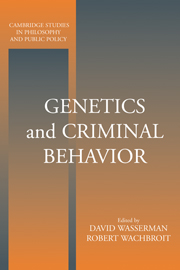Book contents
- Frontmatter
- Contents
- List of Contributors
- Acknowledgments
- 1 Introduction: Methods, Meanings, and Morals
- PART I
- 2 Understanding the Genetics-of-Violence Controversy
- 3 Separating Nature and Nurture
- 4 Genetic Explanations of Behavior: Of Worms, Flies, and Men
- 5 On the Explanatory Limits of Behavioral Genetics
- 6 Degeneracy, Criminal Behavior, and Looping
- 7 Genetic Plans, Genetic Differences, and Violence: Some Chief Possibilities
- PART II
- Index
2 - Understanding the Genetics-of-Violence Controversy
Published online by Cambridge University Press: 05 June 2012
- Frontmatter
- Contents
- List of Contributors
- Acknowledgments
- 1 Introduction: Methods, Meanings, and Morals
- PART I
- 2 Understanding the Genetics-of-Violence Controversy
- 3 Separating Nature and Nurture
- 4 Genetic Explanations of Behavior: Of Worms, Flies, and Men
- 5 On the Explanatory Limits of Behavioral Genetics
- 6 Degeneracy, Criminal Behavior, and Looping
- 7 Genetic Plans, Genetic Differences, and Violence: Some Chief Possibilities
- PART II
- Index
Summary
The promise of behavioral genetics – especially the prospects of discerning a relationship between genes and violent behavior – is surely one of the most contentious issues in genetics, if not in all of biology. The development of ever more powerful and sophisticated research protocols and techniques of data analysis by some researchers has been greeted with a barrage of methodological complaints by others; whereas some scientists express optimism over the scientific fruitfulness of recent discoveries, others make pessimistic, if not dismissive, assessments of the likelihood of genetic explanations of behavior. And the controversy has not been confined to the lecture room, laboratory, or scientific conference. Many sectors of the public have followed this dispute keenly, some welcoming, others being alarmed by the news – which is often reported with little qualification – of what scientists claim to have demonstrated. While the dispute has sometimes been intense, even confrontational, it has not been generally clear to everyone that several types of issues are in play in the controversy. Indeed, they form a structure of layers, a conceptual hierarchy, in which issues raised at one level presuppose that issues on a different level are not in dispute.
I want to set out this structure not only as a roadmap for understanding the controversy but also as an aid in sharpening the debate. The aim is not merely to clarify conceptual priorities and logical entailments, important as they are to get straight, but also to identify other problems that can arise from mixing levels of criticism.
- Type
- Chapter
- Information
- Genetics and Criminal Behavior , pp. 25 - 46Publisher: Cambridge University PressPrint publication year: 2001
- 3
- Cited by



